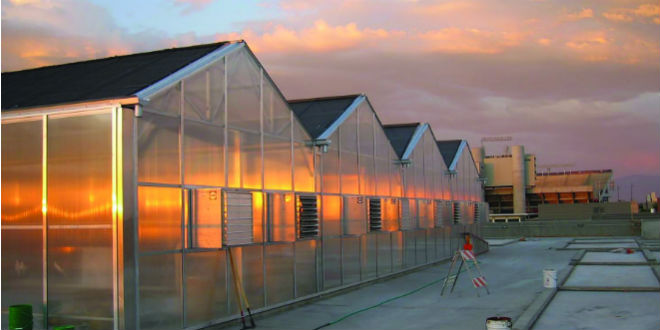Jun 16, 2016Controlled environments growing in popularity
University of Arizona plant scientist and professor emeritus Merle Jensen labeled controlled environment agriculture the “birth of an agricultural revolution.”
A popular response to today’s consumer demand for fresh, healthy, locally grown vegetables, the concept of greenhouse crop production is expanding and now makes a nearly $12 billion contribution to the production food chain.
“Twenty-five years ago, the only people who wanted to talk to me about greenhouse growing were the marijuana cultivators, but that’s all changed now,” Jensen said.
After decades in the emerging industry, he said, “I sometimes feel like a horticultural missionary.”
As early as 1965, Jensen thought it a good idea to try putting air and heat into 150-foot-long row covers and adding water and fertilizer through what he initially termed a “do hose,” which we know today as drip irrigation.
Large-scale growers are converting portions of their fields to controlled environments, and smaller farms are adapting glasshouse technology. Even backyard vegetable growers are setting up mini-operations to keep out pests, lower irrigation costs, harness sunlight and maintain a year-round operation that can avoid freezing temperatures, according to Jensen.
It’s not a new concept. The earliest protected-environment food production is believed to be off-season cucumbers grown “under transparent stone” for Roman Emperor Tiberius. Egyptians and Babylonians grew edible munchies in water gardens some 3,000 years ago, as noted in historical archives.

Up until the mid-1900s, the standard farm routine remained relatively unchanged: dig a hole, plant a seed, water and feed it, pick out unwanted weeds, then harvest the crop and enjoy it. Fast forward to today’s greenhouse or hoop house growers, who now grow in enclosed soil beds or hydroponically.
“It’s growing plants in a solution of water and fertilizer, with or without the use of an artificial medium like sand or peat moss or coconut coir,” Jensen said. “The choice to move farming indoors and grow (controlled environment agriculture) is obvious. We have control over every part of the operation, and can get yields of 10 to 20 times more per square foot. We’ve broken the sound barrier in growing vegetables in greenhouses.”
Because tomatoes love sun, Arizona is a great place to grow them.
“There are some 500 acres now under greenhouse cultivation in Arizona, and under-glass tomato production in our state has grown to a $2.2 billion market,” said Gene Giacomelli, director of the University of Arizona’s Controlled Environment Agriculture Center. The CEAC facility is capable of hydroponically producing some 1,200 tomato, pepper or cucumber plants within its 5,000-plus square feet of heated- cooled-irrigated greenhouse.
“Amber waves of grain aren’t going inside a greenhouse anytime soon, but controlled environment production is a rapidly-growing niche market for specialty items like all varieties of tomatoes, peppers, cucumbers, lettuce, microgreens and strawberries,” Giacomelli said. “The group that is evolving as we speak is the small project farmer, a quarter of an acre (10,000 square feet), or even just a thousand square feet, who wants to grow year round.
“There is still a future for conventional agriculture,” Giacomelli said. “To expect hundreds of thousands of acres of greenhouse farming to replace the open farm is unreasonable, but highly controlled greenhouse growing is already operating in places like the South Pole in Antarctica, and perhaps, someday, even on the surface of the moon or Mars. If that sounds unreasonable, remember that field production and growing under glass are similar in practice, as the basics of plant needs for growth remain the same for all plant production systems.”
Jensen was lead speaker at the annual seminar, “Controlled Environment Agriculture for Food Production within Traditional Rural and Non-Traditional Urban Farms.” He discussed how to successfully grow hydroponic crops under cover, and noted that the concept of greenhouse gardening was being looked at more closely because of increasing climate change issues.
“We’ve got a lot more people who need to be fed, and dirt farmers are selling their fields for urbanization, with homes being built on some of the best agricultural land,” he said. “We have to use a smarter system to grow a lot more food per square foot, horizontally or vertically, with vines going 12 feet up into the air.
“Determine the direction you want to head in before you set out on the journey,” Jensen said, and recommended a basic starter structure 20 to 30 feet wide and 50 to 100 feet long.
Greenhouses, whether freestanding or a three-sided lean-to (attached to an existing structure), don’t come with instruction booklets, so you need to do your homework in advance, he said.
The urbanization of food production is a growth industry, as land for farming becomes less available and more expensive, as drought and changing climate conditions alter standard field production, as labor shortages continue to mount and as the demand for locally and sustainably grown foods increases. Whether in the form of an open garden, garden patches on roof tops or protected environments such as high tunnel greenhouses and/or hydroponics and vertical farming, urban agriculture will play a part in the future development of plant production, according to Jensen.
— Lee Allen, VGN correspondent

















